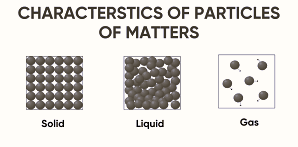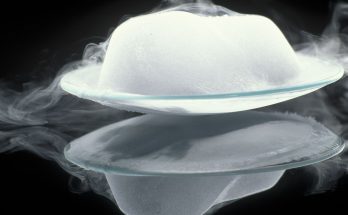Chapter 1- Matter In Our Surroundings One-Line / One-Word Answer Questions with Answers & Explanations
1. What is the SI unit of pressure?
Answer: Pascal (Pa)
Explanation: Pascal is the SI unit of pressure, defined as force per unit area (N/m²).
2. Which state of matter has the highest kinetic energy?
Answer: Gas
Explanation: Gas particles move freely and have the highest kinetic energy compared to solids and liquids.
Also Check – Chapter 1- Matter In Our Surroundings – Class 9 Science – Solved MCQs
3. What is the term for the direct conversion of a solid to gas without passing through the liquid state?
Answer: Sublimation
Explanation: Sublimation occurs in substances like camphor and dry ice, where they change directly into vapors.
4. What is the boiling point of water in Kelvin?
Answer: 373 K
Explanation: The boiling point of water is 100°C, which is equivalent to 373 K (Kelvin = Celsius + 273).
5. What type of force exists between particles of matter?
Answer: Intermolecular force
Explanation: Intermolecular forces hold particles together in solids, liquids, and gases, varying in strength across different states.
Also Check – Chapter 1 -MATTER IN OUR SURROUNDINGS -Class 9 – Simplified Notes
6. Which state of matter is the most incompressible?
Answer: Solid
Explanation: Solids have tightly packed particles with very little intermolecular space, making them almost incompressible.
7. What is the process by which liquids change into gas at any temperature below their boiling point?
Answer: Evaporation
Explanation: Evaporation is a surface phenomenon where high-energy liquid particles escape into the air.
8. What is the latent heat required to convert 1 kg of a solid into liquid called?
Answer: Latent heat of fusion
Explanation: The latent heat of fusion is the energy needed to break the intermolecular bonds in a solid to turn it into a liquid.
9. What happens to the temperature of a substance during its phase change?
Answer: Remains constant
Explanation: During a phase change, heat energy is used to break molecular bonds rather than increasing temperature.
10. Which process is the reverse of sublimation?
Answer: Deposition
Explanation: Deposition is the direct transition of gas into a solid without passing through the liquid phase, like frost formation.
Also Check – Chapter 1- Matter In Our Surroundings – Class 9 Science – Long Question and Answers
11. What is the SI unit of density?
Answer: kg/m³
Explanation: Density is defined as mass per unit volume and is measured in kilograms per cubic meter (kg/m³).
12. What property of liquids allows them to take the shape of their container but maintain a fixed volume?
Answer: Fluidity
Explanation: Liquids flow because their particles are not rigidly held together, allowing them to take the shape of a container.
13. Which gas law explains the effect of pressure on gases at constant temperature?
Answer: Boyle’s Law
Explanation: Boyle’s Law states that at constant temperature, the volume of a gas is inversely proportional to its pressure.
14. What happens to the intermolecular forces when a solid melts into a liquid?
Answer: Weaken
Explanation: The heat energy overcomes some of the intermolecular forces, allowing the particles to move more freely.
Also Check – 82 Reasoning-Based Questions & Answers-Matter In Our Surroundings -Class 9 Science
15. Which physical quantity is directly proportional to the average kinetic energy of a substance?
Answer: Temperature
Explanation: Higher temperature means higher kinetic energy, making particles move faster.
16. Why do gases exert pressure on the walls of a container?
Answer: Random collisions
Explanation: Gas particles move randomly and collide with the walls, exerting pressure.
17. What is the process of turning a liquid into a solid called?
Answer: Freezing
Explanation: Freezing occurs when a liquid loses heat energy and its particles become closely packed to form a solid.
Also Check – Rapid Revision –Chapter 1- Matter In Our Surroundings – Class 9 Science
18. Which phenomenon allows a diver to move easily through water but not through a solid surface?
Answer: Fluidity
Explanation: Liquids offer less resistance than solids due to weaker intermolecular forces.
19. What is the term for the energy absorbed during boiling but not causing a temperature rise?
Answer: Latent heat of vaporization
Explanation: This heat energy is used to break intermolecular bonds instead of increasing temperature.
20. Which factor does NOT affect diffusion?
Answer: Color of the substance
Explanation: Diffusion depends on temperature, molecular mass, and medium, not color.
Also Check – Matter In Our Surroundings – Worksheet with Answer Key
21. Why does an iron rod expand on heating?
Answer: Increased kinetic energy
Explanation: Heating increases particle motion, increasing intermolecular spacing and expansion.
22. What causes the cooling effect in evaporation?
Answer: Loss of high-energy particles
Explanation: The most energetic particles escape, lowering the average kinetic energy and cooling the surface.
23. Which of the three states of matter has the least density?
Answer: Gas
Explanation: Gases have widely spaced particles, making them the least dense.
24. What happens to gas molecules when a gas is compressed?
Answer: They move closer together
Explanation: Compression reduces intermolecular spaces, increasing density and pressure.
25. What is the melting point of ice in Kelvin?
Answer: 273 K
Explanation: Ice melts at 0°C, which is equivalent to 273 K.
Also Chekc – NCERT Exemplar Solutions- Class 9 Science Chapter – 1 – Matter in Our Surroundings
26. Why does steam cause more severe burns than boiling water?
Answer: Higher energy
Explanation: Steam has additional latent heat of vaporization, which releases more energy on condensation.
27. What happens to the diffusion rate when temperature increases?
Answer: Increases
Explanation: Higher temperature increases kinetic energy, causing faster diffusion.
28. What type of phase transition is observed in dry ice at room temperature?
Answer: Sublimation
Explanation: Dry ice changes directly from solid to gas without forming liquid.
29. What is the primary reason gases have no fixed volume?
Answer: Weak intermolecular forces
Explanation: Gases have negligible attractive forces, allowing them to expand freely.
30. In which state of matter do particles have the least kinetic energy?
Answer: Solid
Explanation: Solid particles vibrate in fixed positions and have the lowest kinetic energy.

